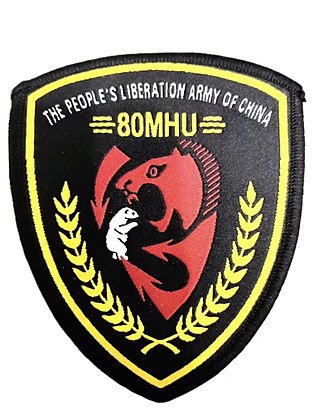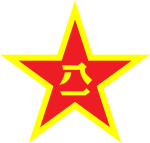
The Beijing Military Region was one of seven military regions for the Chinese People's Liberation Army. From the mid 1980s to 2017, it had administration of all military affairs within Beijing city, Tianjin city, Hebei province, Shanxi province, and Inner Mongolia Autonomous Region. The Region is mainly responsible for defending the People's Republic of China from Mongolia and Russia, and also protects the capital of China, and had the largest number of military personnel of any of the seven regions active from 1985-2017. The Region has now been disbanded and superseded by the Central Theater Command and Northern Theater Command.

The 1st Infantry Division is a military formation of the Republic of Korea Army's I Corps. The division was established on 1947 under the command of Colonel Kim Suk-won.
The 116th Division was a military formation of the People's Volunteer Army (Chinese People's Volunteers during the Korean War with a standard strength of approximately 10,000 men.
The 40th Group Army was a military formation of the People's Liberation Army, active in various forms from 1949 to 2017. It was last located in the Shenyang Military Region and the Northern Theater Command.
The 235th Mechanized Infantry Brigade, formerly the 79th Division, is a military formation of the People's Liberation Army Ground Force. It's now a maneuvering brigade of the PLA 71st Group Army.

The 80th Medium Combined Arms Brigade, formerly the 80th Division, is a military formation of the People's Liberation Army Ground Force. It's now a maneuver part of the PLA 82nd Group Army.
The 20th Group Army is a military formation of the People's Liberation Army Ground Force, stationed in the Jinan Military Region. It consists of two manoeuvre brigades with other attached or otherwise organic units. For some time after its formation in 1949, the army consisted of three divisions.

The 113th Mechanized Infantry Division, now the 113th Medium Combined Arms Brigade, is a military formation of the People's Liberation Army of the People's Republic of China.

The 80th Group Army Chinese: 第八十集团军; pinyin: Dì Bāshí Jítuánjūn), formerly the 26th Group Army, is a military formation of the Chinese People's Liberation Army Ground Forces (PLAGF). The 80th Group Army is one of twelve total group armies of the PLAGF, the largest echelon of ground forces in the People's Republic of China, and one of three assigned to the nation's Northern Theater Command.

Qin Jiwei was a general of the People's Republic of China, Minister of National Defense and a member of the Chinese Communist Party Politburo.
Nie Fengzhi was a general of the People's Liberation Army Air Force (PLAAF) of the People's Republic of China.

The 81st Group Army, formerly the 65th Group Army, is a military formation of the Chinese People's Liberation Army Ground Forces (PLAGF). The 81st Group Army is one of twelve total group armies of the PLAGF, the largest echelon of ground forces in the People's Republic of China, and one of three assigned to the nation's Central Theater Command.
The 1st Armored Brigade is an Armored formation of People's Liberation Army of the People's Republic of China. The brigade now serves as the armored element under the 65th Army in the Beijing Military Region.
During the 1989 Tiananmen Square protests and massacre in Beijing, the Chinese People's Liberation Army (PLA) played a decisive role in enforcing martial law, suppressing the demonstrations by force and upholding the authority of the Chinese Communist Party (CCP). The subject of the Tiananmen protests in general and the military's role in the crackdown remains forbidden from public discussion in China. The killings in Beijing continue to taint the legacies of the party elders, led by Deng Xiaoping, and weigh on the generation of leaders whose careers advanced as their more moderate colleagues were purged or sidelined at the time. Within China, the role of the military in 1989 remains a subject of private discussion within the ranks of the party leadership and PLA.

The 71st Group Army is a formation of the Chinese People's Liberation Army Ground Forces (PLAGF). The 71st Group Army, formerly the 12th Army or 12th Corps, is one of twelve total group armies of the PLAGF, the largest echelon of ground forces in the People's Republic of China. Assigned to the nation's Eastern Theater Command, the primary mission of the 71st Group Army is likely preparation for conflict in or about the Taiwan Strait. The unit is headquartered in Xuzhou City, Jiangsu Province.

The 74th Group Army, formerly the 42nd Group Army, is a military formation of the Chinese People's Liberation Army Ground Forces (PLAGF). The 74th Group Army is one of twelve total group armies of the PLAGF, the largest echelon of ground forces in the People's Republic of China, and one of two assigned to the nation's Southern Theater Command.
The 9th Field Artillery Regiment is a field artillery regiment of the United States Army first formed in 1916. The regiment served in Hawaii during World War I, 3rd, 4th, 7th, and 9th Divisions between the world wars, and with 3rd Infantry Division during World War II and Korea. Since 1957, the regiment has been a parent regiment under the Combat Arms Regimental System and the U.S. Army Regimental System, with regimental elements serving with the 3rd, 4th, 10th, 25th, 79th, 83rd, and 96th Infantry Divisions and various field artillery brigades and groups. The regiment's single active component, the 1st Battalion, 9th Field Artillery Regiment, is assigned to the 2nd Brigade Combat Team, 3rd Infantry Division and stationed at Fort Stewart, Georgia.
The 28th Group Army was an army corps of the Chinese People's Liberation Army that existed from 1949 to 1998. From 1952 to 1971, the 28th Army was based in Putian, Fujian and belonged to the Fujian Military Region. From 1971 to 1998, this army corps belonged to the Beijing Military Region and was based in Shanxi Province, initially in Houma and then in Datong. At the time of its dissolution in 1998, the 28th Army was composed of the 82nd, 83rd and 205th Infantry Divisions, the 7th Armored Division, an artillery brigade, an anti-aircraft brigade, an engineer regiment, a communication regiment and a reconnaissance battalion. The army corps’ unit ID number was 51366.

The Eastern Theater Command is one of the five theater commands of the People's Liberation Army (PLA), founded 1 February 2016. It replaced the Nanjing Military Region. The command is headquartered in Nanjing.







